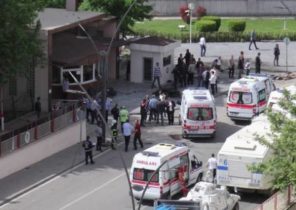In September 2014, Arseniy Yatsenyuk, at that time head of the government, promised to build a wall on the border between Ukraine and the Russian Federation. The need for the construction of physical boundaries arose from the deployment of the war in the East of Ukraine.
The “Wall” consisted of two stages. The first operation in areas outside the conflict zone, the second — on the territories where military actions took place. To complete the project planned in 2018, later the date was postponed to 2021. However, 2020 is coming to the middle, and the construction does not see any end or edge.
During implementation, the project managed to get on pages of pre-trial investigation of NABOO and to the popular name “the wall Yatsenyuk” — in honor of the unfulfilled promises of the former Prime Minister. However, this is somewhat unfair against the former head of the government.
2015 expense budget for the project is the State border service (SBS), controlled by the interior Ministry. For six years this Department is headed by Arsen Avakov. According to HCC, the project “the Wall” is scheduled to move for another four years and terminate in 2025. Total expected cost of the project is 4.1 billion hryvnia.
According to frontier guards, the necessity of extending the border due to decreasing funding and increasing costs. How was built the famous “Wall” and what kind of results were reported by officials?
In the summer of 2019, the work was done by 30%. SBS recently reported that before 2020 the funds provided for the construction of facilities on the Ukrainian-Russian border in 2015-2019, has been spent on 85% of the budget program “measures on engineering and technical arrangement of the border.”
This figure is explained by the fact that at this period the budget has been allocated 2 billion hryvnia, and spent 1,7 billion hryvnias. The reason is the reduction of the amount of funding in 2017 from 500 million USD to 200 million USD. The expenditures by years were distributed as: 2015 — 400 million, 2016 year — 200 million, in 2017 — UAH 200 million, in 2018, 500 million, 2019 $ 400 million hryvnia. For 2020, the project has allocated another 400 million.
For 2015-2019, is provided for a 634 km of engineering obstacles and the gasket 341 km of lateral roads. During this period, was equipped 546 km of fencing and 316 km of roads. That is, if you believe the guards, the said works of the project “the Wall” was performed on 86% and 93%, respectively. What, then, defenders of the border are planning to build over the next five years?
The volume of works and their cost for each year are clearly defined budget program “measures on engineering and technical arrangement of the border.” However, a comparison of the annual passports this budget programmes and their implementation reports showed that between scheduled and performed performance in all cases, there is a significant difference.
For example, the length a in 2017 anti-tank ditches and trenches had to be 110,3 km, however, the implementation rate is 5%, that is the year it was excavated 5.2 km anti-tank ditches and trenches. On this task was spent 1,6 million hryvnias is planned to 30.1 million.
In 2016, the volume of funds allocated to the construction of the Wall has been halved compared to the previous year — to UAH 200 million. Accordingly, the number of the planned works has been reduced. However, the results of the executed works do not meet the plan.
For example, the passport of the budget program provides for the allocation from the state budget of 82.3 million UAH for the construction of 97 km lateral road. Under 82,3 million hryvnias were used 79 million, although the length of the lateral road in 2016 amounted to only 48.4 km, i.e. half of the planned length.
In 2017-2018, the amount of predictable funding has increased significantly: on the “Wall”, the state planned to spend 500 million hryvnia. However, according to the report on the implementation of the passport of the budgetary program, in 2017, it spent 200 million hryvnia.
In 2018 the “Wall” was funded at 500 million. In addition, the completion report is scheduled for 2018 works, in contrast to the report for the previous year, there is a column “explanation of the reasons for the deviations between the cash costs (credits) and approved the passport of the budget program”.
As shown in the chart, the indicators of efficiency of use of budgetary funds in this case, though not ideal, but much higher than in previous years.
At the same time, the cost of some jobs is increased, although the actual results are less than planned. For example, the work on construction of a lateral road crossings through a difficult or unusual terrain cost the state to 119.7 million instead of UAH 103,6 million, however, the year this work was executed only on 85%.
A similar situation exists in 2019. Total expenditure amounted to 400 million hryvnia. Work on laying the road was completed by 105%, while expenses increased by 47.9 million. These works spent amounted to 133, 4 million UAH instead of the planned 85,5 million. Thus, the amount of work performed increased by 5%, the funding amounts to 56%.
In General, the analysis of the implementation of the budget program “measures on engineering and technical arrangement of the border,” showed a lot of confusion in the figures. Annual reports contain different names of the same work, which greatly complicates both financial and civil control over the construction of the “Wall” on the Ukrainian-Russian border.
Abnormally low level of implementation of some operations and the significant increase in the costs of some other works indicate problems in the planning of the SBS. This is not to say that the border service too has suffered from reduced costs, because the decrease occurred only in 2017.
In the Department reports on the project for the 2018-2019 extension of completion date to explain the rise in the cost of labor and materials, decrease in the volume of allocated funds delay in project documentation development, difficulties with delivery of materials and execution of works in the location.
It is obvious that during the planning procedure for the implementation of the following works should provide for their phased implementation within the available budget during the year. Of course, with all conventional anti-corruption practices.
Five years ago, the financing of the project “the Wall” was justified by the pressing needs of national security. Now this project runs the risk to stretch to ten years and become such a small domestic analogue of the great wall.
The current government is obliged to complete it as soon as possible. Moreover, responsible for the project, the Minister Avakov and in 2020, retained his seat.







